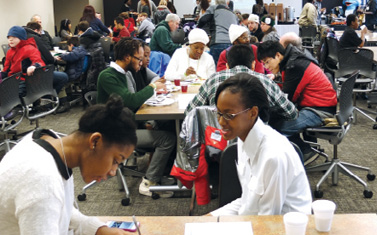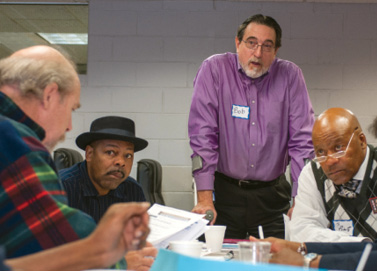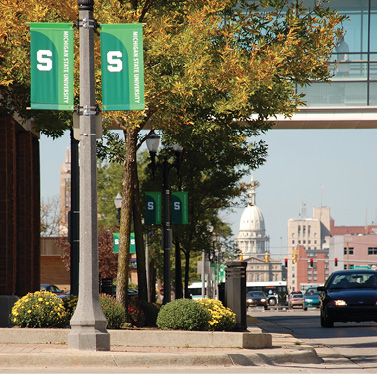Capacity Building in Detroit, Flint, and Lansing
University Outreach and Engagement (UOE) at MSU facilitates projects and initiatives that are both rooted in and responsive to the needs of specific communities, especially those underserved in terms of access to economic and cultural resources. Rather than working in isolation, these initiatives seek to draw on and bring together the collective strengths of existing programs and organizations to create an even greater impact in the communities they serve. Below are three examples of "places" in which UOE is able to serve as a nexus, connecting the strengths of the University with the strengths of the community.
The MSU Detroit Center

Community members gather for a Thanksgiving Day Parade fundraiser at the MSU Detroit Center.
The MSU Detroit Center, located in the Brush Park Historic District along Woodward Avenue, serves as a nexus for collaborative partnerships between MSU and many organizations in the surrounding area of Detroit and southeast Michigan. The Center houses several MSU units, including the College of Music's Community Music School – Detroit; the College of Education; Admissions; Advancement; and Governmental Affairs, each building on their own relationships within the community.
Jena Baker-Calloway is the director of the MSU Detroit Center, as well as the director of the MSU – Detroit Partnerships Office at YouthVille Detroit (also on Woodward Avenue), which currently houses MSU Extension, School of Social Work, and College of Engineering programs. But her responsibilities extend far beyond oversight of the offices. "While I'm the director of the Detroit Center, my UOE hat also involves fostering relationships with organizations and thinking creatively about how the University can be connected with the work that is happening in the community," she said.
Why the Focus on Place?
...Because place matters a great deal in the life chances of individuals. Place influences the quality of the housing in which we live; the quality of schools that our children attend; the availability of nutritious food; access to safe spaces for recreation; air, water, and soil quality; the availability of jobs; and access to public transportation…Roux and Mair (2010) identified a wide range of neighborhood-level factors that influence health, including residential segregation by race/ ethnicity and class; features of neighborhood physical environments such as environmental exposures, food and recreational resources, the quality of the built environment, and housing; and features of neighborhood social environments such as level of safety and violence, social connections and cohesion, local institutions, and local norms. Given that place has a profound impact on the health and life chances of people, working with people to transform the places in which they live for the better is a primary goal of SE [systemic engagement].
McNall, M. A., Barnes-Najor, J. V., Brown, R. E., Doberneck, D., & Fitzgerald, H. E. (2015). Systemic engagement: Universities as partners in systemic approaches to community change (p. 7). Journal of Higher Education Outreach and Engagement, 19(1), 1-25.
Under Baker-Calloway's leadership, the MSU Detroit Center offers practical support to community development by creating collaborative partnerships among a broad range of disciplines and with external constituents.
"I'm always on the lookout for ways that we can connect the University and what is happening locally to a community that has need. I make myself available to spread the word about what we offer at the Detroit Center, service-wise, space-wise, relationship-wise, as well, and to be a bridge for many people who don't necessarily think of MSU being in Detroit. So, I'm really an ambassador of sorts, providing information about the work that's going on in the region, as well as recommending possible connections to the University and our programs, unique opportunities, scholarships, research possibilities, and various other ways to connect."
An example of MSU Detroit's connection in the city is through MSU's longstanding relationship with Focus: HOPE, a human services organization that has been operating in Detroit since 1967. Several universities, including MSU, are working with Focus: HOPE to develop a university-community concept for collaborative research and action called the Urban Learning and Leadership Collaborative. It's an effort to foster new activity in the 100 blocks that make up the Hope Village area.
"The universities came together because we were all doing our individual work with this particular organization," explained Baker-Calloway. "So we wanted to maximize the efficiency and bring some projects to scale that are led primarily by the needs and wants of the community, as well as those of the universities. It's designed to be co-creative, so the universities aren't leading that effort. It is really a collaborative effort."
Baker-Calloway explained that the MSU Detroit Center is a visual and physical representation of Michigan State University's commitment to Detroit and Southeast Michigan: "We want to provide opportunities through the Center both space-wise, as well as through faculty and staff, to connect and engage with the community that we're in, because we do see Detroit as being critical to the development of the State. In my outreach activities, that's one of the things foremost on my mind: How can we as a university community serve Detroit?"
Capacity Building in Flint

Bob Brown works with community members in Flint.
After 40 years of disinvestment, residents of Flint are coming together in community-based networks to organize grassroots efforts aimed at improving the quality of life in their neighborhoods. Working with partners such as MSU, these citizens are using their existing resources and assets collaboratively to build zero tolerances for violence, create safe places for children and youth to learn-play-grow, dismantle systemic racism, and rebuild civic life in neighborhoods. Bob Brown, associate director of the MSU Center for Community and Economic Development, is a core team member in four of these networks (where multiple MSU faculty and staff participate):
- Regional Food System
"Flint is a food desert," said Brown. "In the past three or four months, the last major grocery stores have closed down and moved out further into the suburbs." This five-year Community Foundation-funded initiative seeks to create a regional food system that is equitable and sustainable.
- Community Action Group
Organized initially by parents of murdered children in Flint, this network undertakes efforts to eliminate violence in neighborhoods including the breaking of codes of silence.
- Neighborhoods Without Borders
This network is working on dismantling systemic racism. Bob Brown describes the work in a video available at soundcloud.com.
- Flint Community Higher Education Partnership
This partnership leverages the scientific resources of several academic partners with the local knowledge resources of residents to create action that helps realize the vision of Imagine Flint's Comprehensive Master Plan (see imagineflint.com). MSU-community projects—including the Photovoice project; What is Hunger; One Day, One World; Spot on Autism; and Dancing Computers—are helping to fulfill the Arts and Culture part of the Master Plan.
According to Brown, each of these networks is a place where "everybody does the thinking, everybody creates ongoing action based on the assets that they have, which moves us toward the larger outcomes that we're seeking." Using Strategic Doing1 (Brown is a nationally certified Strategic Doing trainer) the networks form action-oriented collaborations quickly, move toward measurable outcomes, and make adjustments along the way.
The outcomes pursued are reflective of the participants in each project. "Unlike government funding, where outcomes are often prescribed, we are the ones defining the outcomes with the metrics that make sense to us. Outcomes then become meaningful to those in the room. When you're passionate about what you're pursuing it's more likely you'll stick around for the long term," said Brown.
Since the issues these networks address are so complex, the long-term goal is to help the groups to keep moving along the pathway toward those collectively determined outcomes. "What we're trying to do in each one of these networks is create strategies to get from where we're at to where we want to be—the outcome," said Brown. "But the pathways of getting there are often vague or undetermined. So we need to create strategy that's agile, that's reflective of the people in the room, and that isn't waiting for some other resource to come along. We need to try to create efforts and learn from them on the pathways of moving forward.
"People talk a lot about the power that they feel when they are in control of the action that is being taken to make their community a better place. I've heard people say things like, 'Living in a community that's been disinvested in for 40 years, to come across a way of doing something together that is based on what I can do is so empowering. It makes me feel hopeful.'"
The Power of We Consortium, Lansing

The MSU Center for Community and Economic Development works with many Lansing-based organizations to build capacity.
Formerly the Ingham Interagency Human Services Advisory Committee (HSAC), the Power of We Consortium (PWC) draws on the collective social capital and diversity of over 250 human services, nonprofit, governmental, faith-based, and business sector stakeholders in the greater Lansing area to promote systems reform and achieve positive results for their communities.
According to John Melcher, associate director of MSU's Center for Community and Economic Development, the PWC started under the leadership of the Ingham County Health Department, which wanted to expand the scope of the HSAC to include more community voices. "They were looking at human services from the health department perspective and saying, where we see capacity out in the community, we'd like to partner more with them," said Melcher.
Because of Melcher's experience in community development, he was asked to help give direction to the growing organization: "I started to help form some goals and develop the concept of growing the organization into a more robust community network that could both inform and be informed by the large institutions, as well as the perspective that the work could be done and enhanced by partnering with community-based organizations."
One early example of Power of We networking involves the Allen Neighborhood Center. According to Melcher, the Health Department recognized that the Allen Center could help with health education. "So the Allen people went out into the neighborhood with their kits and talked to people personally door to door about what some of their health needs were," said Melcher. These contacts brought to light other areas of need, such as access to inexpensive and healthy food, so the program expanded through networking into various ways of creating access to food, such as community gardens, a hoop-house, and eventually, a farm market.
According to Melcher, Allen Neighborhood Center reflects the development model of capacity building, geared toward long-term sustainable development, rather than simply providing a series of short-term services. "Services are important, but often our services aren't tied together in a way that creates real opportunity to lift people out of poverty, to help change their life circumstances," he explained.
Another way the Consortium helps build capacity is by offering training and mentoring to small nonprofit organizations. Through the process of applying for a Compassion Capital Fund grant, Melcher and members of the PWC's Investor Steering Committee aimed to enable community organizations, such as nonprofits, to become major players in building the capacity of their own communities: "What we were proposing was to develop, train, and mentor existing nonprofits and to help fledgling new ones that were emerging to get some skills and capacity to manage themselves well." The partners' first application was denied, but after collaborative development of the plan they were able to submit a successful reapplication.
Melcher's work with the PWC allows him to be a nexus between smaller community organizations and large institutions: "Power of We was predicated on a model that suggests we can help to empower communities with a vision of being able to bring nonprofits together with the big institutions to talk about some of these issues of concern and strategize about how we might work together to address them." He recognizes the ability of MSU to bring a level of expertise to the development of the Power of We Consortium. "It was that force to be able to give a vision," said Melcher, "and to help articulate some different models that people would then be able to grab the pieces they wanted and help shape and form it into what we see today as the Power of We Consortium."
Sources
- See The Engaged Scholar Magazine, Vol. 6, Fall 2011, p. 33, for more information about Strategic Doing. Retrieved from: https://engagedscholar.msu.edu/magazine/volume6/morrison.aspx.Return to text
- Written by Amy Byle, University Outreach and Engagement